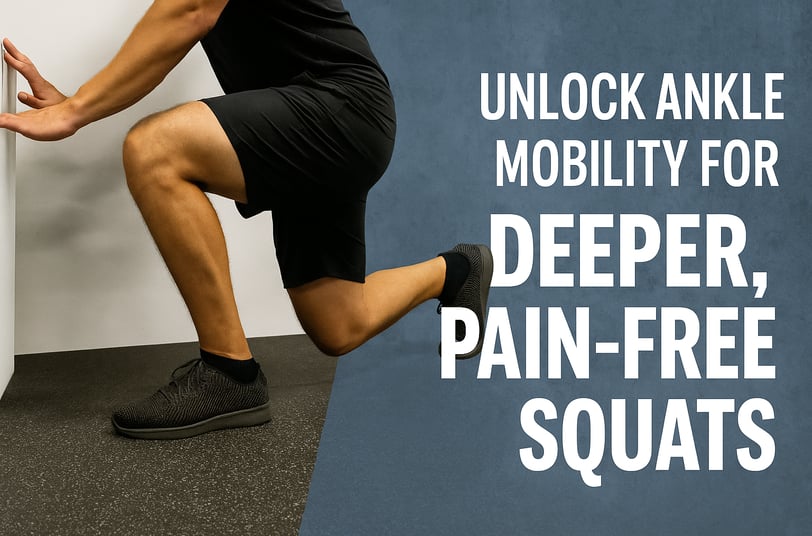Unlock Ankle Mobility for Deeper, Pain-Free Squats (3 Easy At-Home Fixes)
Struggling with shallow squats or knee pain? Tight ankles might be the reason. Discover 3 simple, gear-free moves to improve ankle mobility, boost squat depth, and move pain-free—plus top tools to support your progress at home.
5/21/20253 min read


Unlock Ankle Mobility for Deeper, Pain‑Free Squats
Struggling to hit depth on your squats or feeling strain in your knees and lower back? Tight ankles are often the silent culprit. Improving ankle mobility helps you squat deeper, maintain balance, and move pain-free. Even better: you can get results with just three simple moves—no fancy equipment required.
Why Ankle Mobility Matters
Your ankles play a key role in squat form. Poor dorsiflexion (your foot bending upward) can cause your heels to lift or your knees to cave—leading to shin strain, compromised balance, and low‑back compensation. By unlocking better ankle range, you’ll stack up joints properly and distribute load evenly through your legs.
Three Easy Moves You Can Do Anytime
1. Wall-Assisted Ankle Stretch
Setup: Stand about 4–6 inches from a wall, facing it.
What to Do:
Place one foot flat, toes a few inches from the wall.
Keep your heel grounded and bend the front knee forward toward the wall.
Stop when you feel tension in your calf/Achilles—not pain.
Hold 30 seconds, repeat 2–3 times per side.
Why It Works: Encourages dorsiflexion while controlling tibial movement. Over time, your ankle becomes more flexible under load.
2. Calf Foam Stretch Using a Wedge (No Roller)
Setup: Use a sturdy platform like a thick book, board, or yoga mat stack.
What to Do:
Place the ball of one foot on the edge.
Let the heel drop below the platform level.
Feel a stretch in the calf and ankle front.
Hold for 30–45 seconds, 2 sets each side.
Why It Works: Passive stretch targets calf and Achilles, reducing stiffness and improving pull-up of the shin over the foot during squat.
🛠️ Product we recommend : Adjustable Squat Wedge – Heel Elevated Slant Board
What It Is: A portable wedge that props the heel at a fixed incline for deeper squats and calf stretches Amazon.
Why Try It: Holds a consistent angle, so you can safely zero in on ankle mobility without balancing. Great for both warm-ups and squat setups.
How to Use: Stand on it during your wall-assisted stretches or simply step onto it before squatting to ease depth and reinforce ankle flexibility.
3. Knee-to-Wall Knee Drives (Dynamic Mobility Drill)
Setup: Stand a couple of inches from the wall, side view.
What to Do:
Keep heel flat, drive the knee forward to touch the wall.
Step back and repeat controlled reps—10 reps per side.
Add a slight lunge stance for deeper stretch.
Why It Works: Builds dynamic dorsiflexion under moving weight. It mimics how your knee travels during a squat.
Quick Routine Suggestion:
5 wall-assisted holds (30 sec each)
2 calf holds on wedge
10 knee-drive reps per side
Do this daily or before workouts for noticeable progress in just a week.
🛠️ Product we recommend : Foot and Calf Stretcher/Stretching Strap
What It Is: A fabric strap with loop handles used to pull your foot into dorsiflexion and plantar flexion positions Amazon.
Why Try It: Enables precise control of stretch angle, useful for both sitting and standing mobility drills. Perfect if you’re tight in shoes or need subtle tuning.
How to Use: Loop over the forefoot, anchor the strap, and gently pull your toes toward you to stretch calf and shin.
Integrating Mobility Into Your Day
You don’t need a gym—just consistency. Here’s a simple template:
TimeRoutineMorningQuick knee-drive warm-up and wall stretch (3–5 min)Pre-WorkoutFull sequence: wall stretches, wedge calf holds, knee drivesEveningStrap stretches for 5 minutes to prep your ankles overnight
Repeat regularly—you’ll gradually feel deeper flexibility, more stability in your knees, and smoother squats.
🛠️ Product we recommend : Ankle Balance Board Trainer
What It Is: A wobble board or tilting balance platform that challenges foot and ankle stability Amazon.
Why Try It: Post-stretch workout for proprioception and ankle strength. Building soft-tissue stability helps maintain newly gained mobility.
How to Use: Stand barefoot on the board and perform 1–2 minutes of gentle balance exercises—rock front-to-back and side-to-side, or catch a ball. Do this after your mobility routine or workout.
Why This Works Longer-Term
Stacked Joint Mechanics: Working ankles in isolation and in movement (knee drives) ensures you’re building both flexibility and function.
Balanced Approach: Stretching plus loading (balance board) creates sustainable gains. Stretch alone, and you risk floppiness; train alone, and you stay tight.
Low Barrier: No complicated gym gear—just bodyweight, gravity, and inexpensive tools when you want to level up.
Progress to Look For
Week 1: Ankles feel less stiff and you notice being able to squat deeper with heels flat.
Weeks 2–3: Knees can move forward over toes without the heel lifting and squat position feels more natural.
By Month 1: Squats feel smoother, your body lines up better, knee discomfort fades, and you’re able to go deeper without pressure.
Final Thoughts
Ankle mobility is often overlooked—but it’s the foundation of posture, squat form, and ankle health. By spending just a few minutes a day on simple drills and using smart, inexpensive tools, you can unlock deeper, pain-free squats and carry that mobility into your daily life.
Let me know if you'd like a printable routine guide or smartphone reminders to keep you consistent and pain-free!
FITNESS
Nutrition
WellnesS
info@movebetterco.com
© 2025. All rights reserved | Privacy Policy | Terms & Conditions